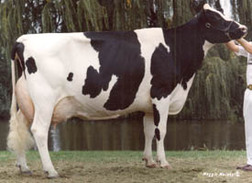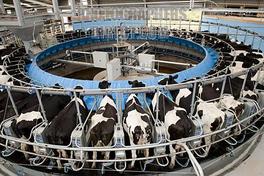The dairy industry is a very important industry in agriculture. Nearly every morning, I wake up and enjoy a glass of milk, as do many other people around the world. Without the nutrients that we get from dairy products our teeth and bones would be very weak. As a member of the 2010 Alabama State winning Dairy Judging team, I learned a lot about the importance of the dairy industry. I also learned exactly how our milk gets from the cow to the kitchen table. Below you can find the process that it takes to get milk to your kitchen table, and a few facts about the dairy industry.
The Process: How does the milk get from cow to the kitchen table?
First, the cows are rounded up to the dairy or milking parlor for milking. There, the cows are led in to be milked. Suction cups are then put on the cows udders to suction out the milk. After milking the cows, the suction cups are removed and the cows’ teats are sprayed with a disinfectant to prevent infection. After all the cows have been milked, the milking parlor/dairy is then washed out and cleaned. The milk is stored in the refrigerated vats until the milk truck arrives to collect it. When the milk truck arrives to pick up the milk it is taken to the factory for processing. While at the factory milk is tested, pasteurized to kill bacteria, and homogenized to prevent the cream from separating and settling on top. After this, the milk is sent through a processing line and bottled. The milk is then sent to supermarkets and other shops. Then, of course, we buy the milk! That is how the milk gets from the dairy farm to our kitchen table!
Udderly Amazing Facts!
In a year’s time a dairy cow produces 1,500 gallons or 6,000 quarts of milk. A Jersey cow will give as much as 3 to 4 gallons or around 16 quarts of milk each day.
Dairy cows provide us with milk and milk by-products like cheese, butter, and ice cream. In addition, milk is also used to manufacture glue, paint, and plastics.
Straight from the cow, the temperature of cow’s milk is about 97 degrees Fahrenheit.
One cow can give 200,000 glasses of milk in a lifetime!
It takes approximately 1.4 gallons of milk to make 1 gallon of ice cream.
Cheese was made over 4,000 years ago in Asia.
A cow has one stomach with four compartments. They are: the rumen, where the food is first stored, the reticulum, where food that has been more thoroughly chewed is stored once the cow has chewed the cud and has swallowed it; the omasum, where extra water is squeezed out, and finally the food goes to the abomasum. Some of the digested food is then stored in the cows udder where it is made into milk.
A typical, full grown Holstein cow weighs about 1,400 pounds and produces 60 pounds of milk per day.
One day’s production is 2.6 pounds of butter, 7 gallons of milk, or 6 pounds of cheese.
A dairy cow consumes 35 gallons of water, 20 pounds of grain and concentrated feed and 35 pounds of hay or silage in just one day!
It usually takes about 20 minutes for a cow to be milked. On average a cow is milked 2 to 3 times a day.
Hamburger meat from a single steer will make about 720 quarter pound hamburger patties. That is enough for a family of 4 to enjoy hamburgers each day for nearly 6 months.
Dairy cows provide us with milk and milk by-products like cheese, butter, and ice cream. In addition, milk is also used to manufacture glue, paint, and plastics.
Straight from the cow, the temperature of cow’s milk is about 97 degrees Fahrenheit.
One cow can give 200,000 glasses of milk in a lifetime!
It takes approximately 1.4 gallons of milk to make 1 gallon of ice cream.
Cheese was made over 4,000 years ago in Asia.
A cow has one stomach with four compartments. They are: the rumen, where the food is first stored, the reticulum, where food that has been more thoroughly chewed is stored once the cow has chewed the cud and has swallowed it; the omasum, where extra water is squeezed out, and finally the food goes to the abomasum. Some of the digested food is then stored in the cows udder where it is made into milk.
A typical, full grown Holstein cow weighs about 1,400 pounds and produces 60 pounds of milk per day.
One day’s production is 2.6 pounds of butter, 7 gallons of milk, or 6 pounds of cheese.
A dairy cow consumes 35 gallons of water, 20 pounds of grain and concentrated feed and 35 pounds of hay or silage in just one day!
It usually takes about 20 minutes for a cow to be milked. On average a cow is milked 2 to 3 times a day.
Hamburger meat from a single steer will make about 720 quarter pound hamburger patties. That is enough for a family of 4 to enjoy hamburgers each day for nearly 6 months.


